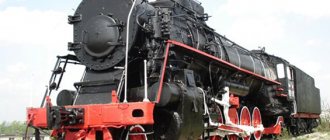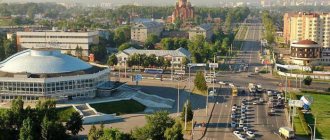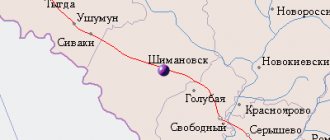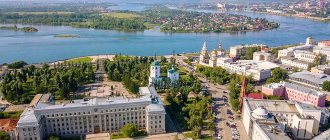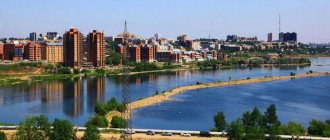Traveling around Russia is an exciting experience. And many tourists prefer to spend their holidays in their native lands rather than go to distant countries. Indeed, in addition to the unknown and interesting places that await tourists along the way in the vastness of their homeland, they should take into account different time zones and climatic conditions. One of these places is the city of Taiga (Kemerovo region).
Many even experienced travelers ask questions: “Where is the city of Taiga? And what remarkable things can you see there?” And indeed there is little information about this city, and it is difficult to call this place a tourist place.
brief information
Taiga (Kemerovo region) is a small city. As of 2015, just over 24 thousand people lived here. Due to the annual sharp decline in the population and the deterioration of the socio-economic situation, it was given the status of a single-industry town of the Russian Federation.
Taiga is 124 km away from the regional center, which is Kemerovo. The closest city to it is Tomsk - only 80 km away. The capital of the Russian Federation is located at a distance of 3.5 thousand km, and the nearest airport is sixty kilometers away. The map of Taiga of the Kemerovo region, which can be viewed below, displays the location of the streets.
Links
Sources
- Council of People's Deputies of the Kemerovo Region. Law No. 215-OZ of December 27, 2007 “On the administrative-territorial structure of the Kemerovo region,” as amended. Law No. 131-OZ of December 22, 2014 “On Amendments to the Law of the Kemerovo Region” On the status and boundaries of municipalities “and the Law of the Kemerovo Region” On the administrative-territorial of the Kemerovo Region “”. Came into force on the day following the day of official publication. Published: “Kuzbass”, No. 243, December 28, 2007 (Council of People’s Deputies of the Kemerovo Region. Law of December 27, 2007 No. 215-OZ “ On the administrative-territorial structure of the Kemerovo region”
as amended by the Law of December 22, 2014 No. 131-OZ “
On Amendments to the Law of the Kemerovo Region”).
“On the status and boundaries of municipalities” and the Law of the Kemerovo region “On the administrative-territorial structure of the Kemerovo region” . Effective from the day following the day of official publication.). - Council of People's Deputies of the Kemerovo Region. Law No. 104-OZ of December 17, 2004 “On the status and boundaries of municipalities,” as amended. Law No. 123-OZ of December 22, 2015 “On amendments to the Law of the Kemerovo Region” On the status and boundaries of municipalities “”. Came into force on the date of official publication. Published: “Kuzbass”, No. 242, December 24, 2004 (Council of People’s Deputies of the Chelyabinsk Region. Law of December 17, 2004 No. 104-OZ “ On the status and boundaries of municipalities”
as amended by the Law of December 22, 2015 No. 123-OZ “
On Amendments to the Law of the City of Kemerovo”).
Area “On the status and boundaries of municipalities” . Effective from the date of official publication.).
A little history
The formation of the city is directly related to the construction of the Trans-Siberian Railway. It was thanks to her that this region began to be populated. The railway station began operating in 1896. The urban settlement of Tomsk-Taezhny was built nearby. Its construction was due to the fact that another large railway line to Tomsk was to be built from Taiga station. However, its construction was never completed, and the village was strengthened.
Initially, Taiga (Kemerovo region) was listed as a railway station between the Berezovaya and Kitat rivers (tributaries of the Yaya River). However, gradually the population of the town increased to 10 thousand people, and it was decided to give the town the status of a city. This happened in 1911.
The name of the city is associated with the geographical term “taiga”, which denotes a natural area with a predominance of coniferous forests. The meaning of this word was fully justified. This city was surrounded by a continuous impenetrable forest, which corresponds to this natural zone.
Borders and territory
Pilninsky district
Before considering the cities of the taiga, we will describe the features of the geographical location of this zone. It occupies most of the Scandinavian Peninsula, Finland. For Russia this is the largest landscape zone. Its boundaries are as follows:
- In the south – it starts from the Gulf of Finland and goes to the Urals.
- In the east it stretches from Altai to Amur.
Most of Siberia and the Far East are located in this zone. The taiga territory is huge, so it is usually divided into 3 subzones:
- Northern, where low vegetation predominates and there are spruce and pine trees growing singly.
- Average. Here the world of flora is much more abundant and is represented by various types of conifers.
- Southern, even richer in forests.
On the territory of each of them there is a large number of settlements.
Location and climate
The city of Taiga (Kemerovo region) lies within the Kuznetsk Basin (intermountain region in Western Siberia). The average altitude above sea level is within 200 m, the highest elevation reaches 450 m.
The climate of the city is sharply continental. Taiga has a fairly long winter, lasting from late October to early April. Summer is short, quite warm, but very humid. The average temperature in the city in winter is -14–17°C, in summer – +16–+19°C. The average annual precipitation is 500 mm, and more than half of it occurs in the summer.
Historical milestones
By the time the Kemerovo region was formed, the population of Taiga was slightly more than 30 thousand people. At that time, there were two functioning churches in the city, a railway workers’ club was opened, and a local newspaper was published. This became an important event, which the population of the city was proud of at that time.
Taiga and the city leadership were able to open the first hospital back in 1943. Over time, this hospital became one of the best in the region. In addition, several secondary schools were opened. In 1940, a railway school was inaugurated in Taiga.
Separately, it should be noted that about 5 thousand people left the city of Taiga for the front during the Second World War and only half of them returned. Today's Taiga residents remember the exploits of their fellow countrymen. The streets of the city are named after the heroes and participants of the Second World War; grateful descendants built a memorial to the Taiga residents who left and died in the war.
Economy
Taiga (Kemerovo region) is a single-industry town. The basis of industry, economy and work of the population is the railway junction. The station is built in such a way that the tracks go around it on both sides. The main lines go to Tomsk and Kemerovo. On the basis of the railway junction there is a locomotive repair depot, a repair and technical school, a track and power supply line and a branch of the Institute of Railway Transport. There are 12 structural divisions in total.
More than 60% of the city's working population is employed at railway enterprises. There are also industrial institutions operating in the city. The light industry (a textile factory produces school uniforms and work clothes for railway workers) and food industries are developing.
Communication
Natural taiga zone
Alexandra Shishkina (Egorova)
,
1 Jul 2022 at 13:00
A grandson was recently born, already his fourth.
Answer
1
Dating in nearby cities:
Kemerovo Novokuznetsk Belovo Fireboxes Zelenogorsky Kiselevsk Guryevsk Yurga Anzhero-Sudzhensk Berezovsky Leninsk-Kuznetsky Mariinsk Mezhdurechensk Myski Osinniki Polysayevo Prokopyevsk Salair Tashtagol Shumikha Mezhdugornoye Rudnichny Tisul Artyshta Bachatsky Belogorsk Verkh-Chebula Gramoteino Izhmorsky Inskoy Itatsky Kaz Kal tan Karagailynsky Kedrovka Krapivinsky Krasnobrodsky Krasnogorsky Kuzedeevo Malinovka Mundybash New Gorodok Industrial Starobachati Staropesterevo Taizhina Temirtau Trudarmeisky Chistogorsky Sheregesh Yasnogorsky Yashkino Tyazhin Yuzhny Kamenka Red Kaltan Zvezdny Alekseevka Krasny Yar Zyryanka New Rawn Kharkov Log Prokopievo
Share
Previous city Dating Salair (Kemerovo region) Next city Dating Tashtagol (Kemerovo region)
#overheard # let's meet
#
nearby
#
announcements
#
Chat
#
Sign up
# positive
#
looking for you
#
girl
18-20 years old #
find
#
guy
#
flirting
#
woman
over 35-40 years old #
man
over 45-50 #
want
#
to meet
#
family
#
real
#
typical
#
VK
# Confessions
#
News
#
Weather
#
Forum
# love
Better than: # Mamba
#
Tabor
#
Shura Mura
#
Loveplanet
Attractions
There are not many local attractions in the city itself. Probably the main and only interesting object can be called the railway station - the place from which the whole city began. This is one of the few buildings whose construction took place in the pre-revolutionary period. The building has been standing since 1905, but it requires reconstruction. Next to it you can see two more buildings from the early 20th century - a locomotive depot and a water tower. Since 1954, there has been a steam locomotive on the pedestal, which is considered a monument to the labor feat of railway workers.
Two historical monuments of the city are the monument to the victims of political repression and the monument-memorial to the Taiga soldiers. There is also a Museum of Local Lore.
On the southern outskirts you can find several historical buildings: the pseudo-Russian Church of St. Andrew of Crete, built in 1907, the shop of the merchant Magazov and several residential buildings of the early 20th century.
City for tourists
Among tourists, one can hardly find the city of Taiga on the list of must-sees. But those who find themselves here are advised to visit the local station, the building of which was built before the revolution. A pedestal was installed on the territory of the railway station in 1954, as a memory of the exploits of railway workers, steam locomotive P36 -0192.
And although Taiga cannot boast of ancient artifacts or modern skyscrapers, this city can give tranquility and authenticity to everyone. In addition, the history of the city is closely intertwined with the great construction project of that time - the Trans-Siberian Railway.
Let's sum it up
Within 100 km from this settlement there are two large cities - Kemerovo and Tomsk. Here, in addition to the railway, there is also bus transport - route taxis.
The city of Taiga (Kemerovo region), unfortunately, often experiences problems with water supply. Unlike other Siberian settlements, it is not located near the coast of a large river. Accordingly, this suggests that there is no natural source of water supply in the city. Local residents use the resources of the large nearby river Yaya.
Famous people of Taiga
Inna Vladimirovna Makarova was born in Taiga , and writer Vladimir Alekseevich Chivilikhin .
Gleb Maximilianovich Krzhizhanovsky in Taiga
In 1900-1901 at the station. Taiga worked as a figure in the revolutionary movement of Russia, Soviet state and party leader, scientist Gleb Maximilianovich Krzhizhanovsky (1872-1959). G. M. Krzhizhanovsky, together with his friend V. I. Lenin, participated in the creation of the St. Petersburg “Union of Struggle for the Liberation of the Working Class.” In 1895 he was arrested, and in 1897 he was exiled to Siberia for 3 years. Krzhizhanovsky spent most of his exile in the Minusinsk district (from 1898 - Minusinsk district) in the village. Tesinskoye (Tes) and the city of Minusinsk. Here he continued his revolutionary activities with Lenin, who was also serving exile in the Minusinsk district - in the village. Shushenskoye.
After the end of his exile, G. M. Krzhizhanovsky was forbidden to live in the largest cities of the Russian Empire, and he decided to stay in Siberia. At the station Taiga, he was offered the high position of assistant to the head of the Taiga section of the traction service - head of the depot with a significant salary for those times of 1800 rubles. in year. In March 1900, Krzhizhanovsky began his work. In Taiga, he, along with his wife Zinaida Pavlovna and mother Elvira Ernestovna, settled in a government apartment. Soon, Gleb Maximilianovich created a local Marxist cell. In September 1901, the Krzhizhanovsky couple went abroad for a while.
In 1920, G. M. Krzhizhanovsky was the chairman of the State Commission for Electrification of Russia (GOELRO), in 1921-1923 and 1925-1930 - chairman of the State Planning Committee, in 1929-1939 - vice-president of the USSR Academy of Sciences. Krzhizhanovsky is the author of the Russian text of a number of revolutionary songs, including “Varshavyanka” by V. I. Sventsitsky (known in adaptation as “Hostile whirlwinds are blowing over us”).
Characteristics of the natural area
The largest taiga massif is located on the Eurasian mainland. It begins in the Scandinavian countries - Norway, Sweden, and Finland. Then it stretches across the entire Russian territory, ending on the Pacific coast. This is the largest natural area on the planet.
There is another taiga forest belt on the North American continent. There green areas stretch from east to west. They occupy vast areas of the northern United States, Canada, and Alaska.
Taiga is the northernmost forest zone. That’s why conifers are predominantly common here: pine and spruce. After all, deciduous trees do not grow in cold climates. Taiga forests produce a lot of oxygen. For this they are called the “green” lungs of the Earth.
Taiga beauty (adsbygoogle = window.adsbygoogle || []).push({});
Let's look at the most beautiful cities in the taiga:
- Syktyvkar.
- Bratsk
- Kostroma.
- Khanty-Mansiysk.
- Irkutsk
- Nizhnevartovsk
- Permian.
Syktyvkar is a beautiful and modern center of the Komi Republic, where tourism is rapidly developing. Bratsk is known for the fact that a large number of species of flora grow on its territory: pine, aspen, birch, Siberian larch, alder, rowan.
Another very interesting city in the taiga is Kostroma. The famous Ipatiev Monastery is located here, on whose territory the comedy “Ivan Vasilyevich Changes His Profession” was filmed. The quality of Kostroma flax is known even abroad.
Khanty-Mansiysk is the capital of the largest Russian oil region, rich in elegant monuments of temple architecture.
Irkutsk is one of the largest cities in Siberia, through whose territory the Angara River flows, dividing it into two parts. Forests and reservoirs have been preserved on the territory of the city; more than 1000 species of plants grow, some of which are included in the Red Book and are protected objects. The abundance of park areas and gardens is aimed at improving the environmental situation of a large industrial center.
Nizhnevartovsk is the center of the oil industry
Cedars, birches and pines grow on its territory; there is a Center for National Cultures, where attention is paid to preserving the peculiarities of life and traditions of the Khanty and Mansi. Perm is a modern European city where industry and science are developing
There are many gardens and parks, and vegetation is constantly being planted.
The cities of the taiga are surprisingly diverse and have a rich history. Often on their territory you can find monuments of past eras, amazing natural beauty, and unusual traditions.
Location of taiga on the map of Russia
The taiga of Russia (photo maps of natural zones can be seen later in the article), which is characterized by different climatic zones, is located in a moderate humid climate. Coniferous trees form the basis of its plant life.
There are many swamps in forests of this type. They mainly cover the lands of northern Siberia, as well as mainland Canada.
Passes through the cities:
- Yaroslavl;
- Nizhny Novgorod;
- Pskov;
- Ekaterinburg;
- Tomsk;
- Chita;
- Komsomolsk-on-Amur.
Green areas cover a significant area of the entire Siberian Plain and are also located in the Far East. They cover the Ural, Sayan and Altai mountains. As well as the highlands of the Baikal region, Sikhote-Alin, Greater Khingan. This climatic taiga zone is the longest on Earth. Its length is more than 7000 km from west to east.
The taiga is divided according to the nature of vegetation into 3 subzones in the direction from south to north:
| South | It is distinguished by a rich variety of flora and fauna. There are small-leaved and broad-leaved tree types. The climatic conditions are warm. Summer is hot and lasts about 4 months. Swampiness is low. |
| Average | Its peculiarity is moderate weather. The region experiences warm summers. Winter is harsh, but not frosty. There are many swamps of different types in the taiga. Because of this, the area is characterized by high moisture. Mostly spruce forests and blueberry bushes are common. |
| Northern | It is characterized by harsh winters, cold weather, and cool summers. Spruces and low pines growing sparsely reign here. |
Main cities (adsbygoogle = window.adsbygoogle || []).push({});
The largest cities in the taiga include:
- Velikiy Novgorod.
- Saint Petersburg.
- Arkhangelsk.
- Petrozavodsk.
- Rybinsk.
- Pskov.
- Vologda.
- Ekaterinburg.
St. Petersburg, Veliky Novgorod and Pskov are located at the intersection of taiga and mixed forests. Arkhangelsk is rich in vegetation characteristic of the taiga zone: pines and spruces, larches. Petrozavodsk is a city built on the shores of Lake Onega and known for its rich history. Rybinsk is famous for the largest reservoir in Europe, Vologda is famous for the work of lacemakers. Yekaterinburg amazes travelers with its amazing architectural monuments.
Features of nature in the taiga
The taiga of Russia (photo taken from a helicopter) is distinguished by impassable thickets with swampy soils. There are a lot of windbreaks and dead wood in it. In the Amur basin, coniferous tracts are replaced by large-leaved forest stands. Deciduous trees appear.
For example:
- oak;
- Linden;
- birch white, black;
- alder;
- willow;
- aspen.
Due to the harsh climate, abundance of mountains, swampy areas, and many wild animals, the taiga was considered unsuitable for life and agriculture until the mid-19th century. But the government issued a new law in 1896, which obligated scientists to explore the taiga. As a result, it became clear that many areas of the area were suitable for cultivation.
And the swampy taiga contains useful microelements that make it possible to obtain high yields.
